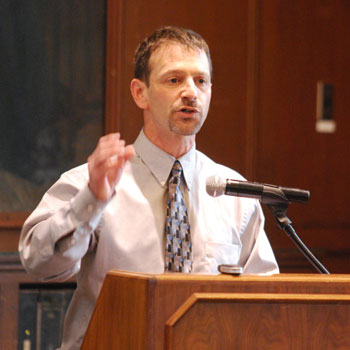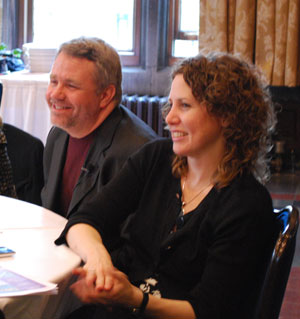The Ecology Center’s Many Shades of Green

Mike Garfield, director of the Ecology Center in Ann Arbor, speaking at the nonprofit's annual meeting on Thursday in the Michigan Union.
Green was the operative word at Thursday night’s annual meeting of the Ecology Center, where around 100 people heard about initiatives that this Ann Arbor nonprofit is leading to build a greener world, and about the challenges in reaching that goal.
They heard about a multimillion-dollar grant recently awarded to Recycle Ann Arbor, with The Ecology Center as a partner, to install green energy technologies at schools and colleges statewide.
They heard from board chair Roger Kerson, director of public relations for the United Auto Workers union, who assured the audience that the center doesn’t spend a lot of money – as in, not a lot of green – on lavish salaries. (This comment drew laughs from the staff.)
And finally, John Warner – who founded and leads the world’s first green chemistry institute – gave a speech that was part tutorial, part pep talk about the benefits of that approach to product design.
So What’s Up at the Ecology Center?
Mike Garfield, the center’s director, began his remarks by referring to an article by Alan Glenn, published in The Ann Arbor Chronicle on April 22, 2009, which traced the role of University of Michigan students and other activists in the first Earth Day – an ambitious movement from which the Ecology Center was born.
Garfield expressed optimism that Michigan has started to take some important steps toward building a green economy. Gov. Jennifer Granholm has begun championing the role of clean energy in the environment, for example, though at the same time eight coal-fired power plant projects have been proposed. He said Granholm’s executive order, issued earlier this year and requiring these proposals to go through a special environmental review, has resulted in the withdrawal of one of those proposals.
Garfield ticked through a long list of projects the center is working on. Related to one of those efforts, he said that on Earth Day this year they took a 25-foot tall yellow rubber ducky to Lansing to raise awareness for the Safe Children’s Products Act – proposed legislation, sponsored by Rep. Rebekah Warren, that would require disclosure of toxic chemicals in children’s products. Garfield noted that local legislators – including state Sen. Liz Brater and Rep. Pam Byrnes, who both attended Thursday’s meeting – were great friends of the environment. He also talked about the databases that the center has developed – focused on toys and cars – to expose the kinds of toxic chemicals in consumer products. The center’s research, he said, is starting to change the way that manufacturers make products.
In addition to national and statewide projects, the Ecology Center is working on several different fronts in Washtenaw County. Those include support of commuter rail proposals, expansion of business recycling programs, and land preservation efforts that they’ve taken the lead on over the past 15 years, such as the Ann Arbor greenbelt and the county’s Natural Areas Preservation. Today, Garfield said, these land preservation initiatives are virtually the only buyers of land in the market, giving them the opportunity to preserve even more land around the county. What’s more, they can use some of this land to build a local, sustainable food system, he said.
Garfield highlighted three new initiatives in which the Ecology Center is playing a part:
Promoting healthy food in hospitals: The health care industry is huge, Garfield said, and hospitals serve an enormous amount of food. Getting the industry to embrace a local, sustainable food supply is the focus of an upcoming conference in Detroit – FoodMed 2009 – which is organized in part by Healthcare without Harm. (Tracey Easthope, the Ecology Center’s environmental health director, is a founding member of that group.)
Energy conservation and renewable energy: Melinda Uerling, Recycle Ann Arbor‘s CEO, spoke briefly about the $3.5 million grant from the Michigan Public Service Commission that was awarded in April, with her agency taking the lead role in a partnership called Energy Works of Michigan. They will conduct energy audits, install renewable energy and energy efficiency technologies like wind and solar power, and provide the curriculum for educational institutions, including K-12 and college-level. Uerling said the grant was a return on the investment they’ve made on the Environmental House Energy & Green Building Resource Center, known as the EnHouse. EnHouse is a model used to promote green building, energy efficiency and renewable energy techniques.
Green chemistry: Tracey Easthope spoke about the state’s push for progress in green chemistry, noting that though Granholm signed a green chemistry executive directive in 2006, there was no money to take action. Now, however, the program has several initiatives, said Easthope, who is a member of the state’s Green Chemistry Roundtable. (Another member is Rebecca Head, an Ann Arbor resident, director of the Monroe County Health Department and chair of the Ann Arbor District Library board.) They have an action plan to accelerate research and education in that field, and Michigan will be the first state to have an award recognizing innovations in green chemistry. That award will be presented in September.
Better Living through Green Chemistry
Easthope introduced the evening’s speaker, John Warner, by describing him as an artist, dreamer and visionary, though he’s best known as a scientist and champion of green chemistry. Turns out he’s also a raconteur. In the course of an hour or so he weaved the narrative of his own life with insights into the field of chemistry, showing how he came to believe in the need for the industry to transform.

John Warner and Amy Cannon at Thursday night's annual meeting of the Ecology Center. Warner was the event's keynote speaker. He is married to Cannon, who received the world's first Ph.D. in green chemistry.
Much of his talk focused on the lack of education that chemists receive about the impact of their work. He described how his two-year-old son died from a liver defect, and how he wondered whether his own work in some way caused the disease. By that time in his career he had synthesized 2,500 compounds and had achieved success in his field, but he had never taken a course in toxicology or environmental hazards. “It’s not part of our educational system,” he said.
After working as leader of a research group at Polaroid, Warner went to the University of Massachusetts and started a green chemistry Ph.D. program. The idea is to create a field of science focused on making safe materials. But not just making materials more environmentally benign than the alternatives – the goal is to make them perform better and be more economical as well.
He had 120 students pass through the Ph.D. program and the average time it took them to get a job after graduation was three days, he said. “Industry wants this – this isn’t a hard sell.”
One reason that industry wants an alternative is related to the cost of the current approach – that approach tries to mitigate the effect of the chemical “nasties” by controlling exposure. That’s led to regulations and expenses for storage, transportation, worker health, liability, community relations and more. “Who in their right mind wouldn’t want an environmentally benign technique?” Warner asked. “I really do believe the next generation wants to do this.”
He also argued that science should be apolitical. (He showed a slide of himself standing next to President George Bush – Warner won a 2004 presidential award for science mentoring – and said “I don’t know which one of us looks more frightened.”) A molecule’s not a Democrat or Republican, not liberal or conservative, he said, and green chemistry should be viewed as just another criteria in product design.
One of the first steps, though, is to overcome the arguments that it’s not possible to make nontoxic chemicals. “Of course it is,” Warner scoffed. “But if we don’t acknowledge it’s possible, we’ll never do it.”
Frustrated by declining enrollment in the field of chemistry at a time when even more scientists are needed, Warner left UMass and founded the Warner Babcock Institute for Green Chemistry and the nonprofit Beyond Benign. While the institute is focused on nontoxic, environmentally benign approaches to product development, Beyond Benign targets science education. “If a child isn’t interested in science by 8th grade, they never will be,” Warner said.
Warner’s goal is to make the term “green chemistry” obsolete – it should simply be the way science is done, he said. He believes it’s possible to achieve that goal: Society wants safe materials. Industry wants to make safe materials. And students want to learn how to do it. “Our job is to give them the skills and together, save the world,” Warner said. “That’s green chemistry.”



